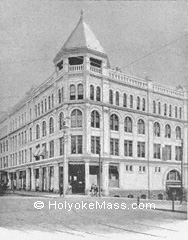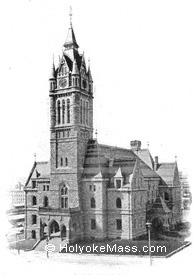
The Marble Building.
|
West Springfield was permitted, May 27, 1696, to "procure and settle a learned and orthodox minister on the west side of the river to dispense the word of God unto those that dwell there." At this time the number of families was between thirty and forty, including about two hundred and fifty persons. A ferry had been established in 1683, and traffic between the dwellers of the two sections was greatly facilitated thereby; and the new measure ripened local interest and promoted more rapid and extended growth. With the growth of Springfield and its villages, the Connecticut towns from the river's mouth to the Massachusetts border had kept pace. John Winthrop the younger had brought his commission from Lords Say, Seal and Brook, to be governor of Connecticut, built a fort at the mouth of the river, calling it Saybrook Fort, and set up his government at Hartford. On account of the distance from Boston, the Springfield colonists at first placed themselves under the Connecticut jurisdiction, but after much discussion of the matter gravitated back to the old allegiance.

City Hall.
|
The colonial governments, although having some differences of this character among themselves, were in practical harmony in dealing with the hostile natives, and their necessary union. for self-preservation doubtless promoted friendly and profitable social and commercial intercourse. Hence, as population gradually crept up the west bank of the Connecticut, the surplus products of the forest, field and river industries readily found their means of transportation to and from the distant markets.
Although it may be impossible to mark the date of the arrival of the venturesome Riley, the pioneer settler who located just north of "Riley Brook," now the southern boundary of Holyoke, his lonely residence was thus located, doubtless purposely, close by the water highway and near the old trail between Springfield and Northampton. We know that the Springfield colonists began to build boats immediately upon their arrival, in one of
© Laurel O'Donnell 1998 - 2006, all rights reserved
This document is an edited adaptation of the original publication and
may be downloaded for personal non-commercial use only.
These pages should not be reproduced or distributed in any format without permission.
|


